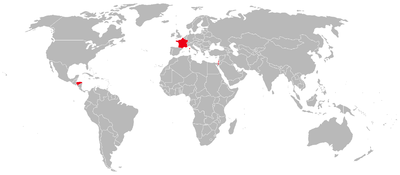Dassault Super Mystère
The Dassault Super Mystère is a French fighter-bomber and was the first Western European supersonic aircraft to enter mass production.
| Super Mystère | |
|---|---|
| Role | Fighter-bomber |
| Manufacturer | Dassault Aviation |
| First flight | 2 March 1954 |
| Retired | 1977 (French Air Force) |
| Status | Retired |
| Primary users | French Air Force Israeli Air Force Honduras Air Force |
| Produced | 1956–1959 |
| Number built | 180 |
Design and development
The Super Mystère represents the final step in evolution which began with the Dassault Ouragan and progressed through the Mystère II/III and Mystère IV. While earlier Mystère variants could attain supersonic speeds only in a dive, the Super Mystère could exceed the speed of sound in level flight. This was achieved thanks to the new thin wing with 45° of sweep (compared with 41° of sweep in the Mystère IV and only 33° in Mystère II) and the use of an afterburner-equipped turbojet engine.
The first prototype Super Mystère B.1, powered by a Rolls-Royce Avon RA.7R, took to the air on 2 March 1954. The aircraft broke the sound barrier in level flight the following day.
As the Super Mystère B.2, sometimes known as the SMB.2, the aircraft entered production in 1957. The production version differed from the prototype by having a more powerful SNECMA Atar 101G engine. A total of 180 Super Mystère B.2s were built.
In 1958, two Super Mystère B.4 prototypes were built. Equipped with a new 48° swept wing and a more powerful SNECMA Atar 9B engine, the aircraft were capable of Mach 1.4. Production never materialized because the faster Dassault Mirage III was entering service.
In 1973, the Israeli Air Force and Honduras Air Force upgraded their Super Mystère B.2s with a non-afterburning version of the Pratt & Whitney J52-P8A and new avionics. In Israeli service these upgraded SMB.2s were also known as the IAI Sa'ar (after a Hebrew word meaning "storm").
Operational history
The Super Mystère served with the French Air Force until 1977. In addition, 24 aircraft were sold to the Israeli Air Force in 1958. The aircraft saw action in the 1967 Six-Day War and the 1973 Yom Kippur War. They were well liked by the Israeli pilots and were a match for the Arab MiG-19 aircraft in air-to-air combat.
In 1976, Israel sold 12 complete airframes to Honduras. In 1979, Honduras purchased 4 more complete airframes, totaling 16 aircraft. They were involved in numerous border skirmishes with Sandinistan Nicaragua and were finally withdrawn from service in 1996, replaced by 12 Northrop F-5Es. The 11 surviving aircraft are for sale as surplus and 1 more is preserved at the Honduras Air Museum.
Operators


- Honduras Air Force[1]
Specifications (Super Mystère B.2)
Data from
General characteristics
- Crew: 1
- Length: 14.13 m (46 ft 4 in)
- Wingspan: 10.51 m (34 ft 6 in)
- Height: 4.6 m (15 ft 1 in)
- Wing area: 32 m2 (340 sq ft)
- Empty weight: 6,930 kg (15,278 lb)
- Gross weight: 9,000 kg (19,842 lb)
- Max takeoff weight: 10,000 kg (22,046 lb)
- Fuel capacity: 2,000 kg (4,409 lb)
- Powerplant: 1 × SNECMA Atar 101G-2 afterburning turbojet engine, 33.3 kN (7,500 lbf) thrust dry, 44.1 kN (9,900 lbf) with afterburner
Performance
- Maximum speed: 1,195 km/h (743 mph, 645 kn) at 11,000 m (36,089 ft)
- Maximum speed: Mach 1.12
- Combat range: 870 km (540 mi, 470 nmi)
- Ferry range: 1,175 km (730 mi, 634 nmi)
- Service ceiling: 17,000 m (56,000 ft)
- Rate of climb: 89 m/s (17,500 ft/min)
- Wing loading: 281 kg/m2 (58 lb/sq ft)
- Thrust/weight: 0.5
Armament
- Guns: 2× 30 mm (1.18 in) DEFA 552 cannons with 150 rounds per gun
- Rockets: 2× Matra rocket pods with 18× SNEB 68 mm rockets each
- Missiles: 2× Rafael Shafrir AAMs
- Bombs: 2,680 kg (5,000 lb) of payload on four external hardpoints, including a variety of bombs, reconnaissance pods or Drop tanks
See also
Related development
Aircraft of comparable role, configuration and era
Related lists
References
| Wikimedia Commons has media related to Dassault Super Mystère. |
- El Salvador AF, esc. caza bomb. (unit history), UK: Aero flight.
- Donald, David; Lake, Jon, eds. (1996). Encyclopedia of world military aircraft. AIRtime Publishing. ISBN 1-880588-24-2.
- Kopenhagen, W, ed. (1987). Das große Flugzeug-Typenbuch [The large airplane type book] (in German). Transpress. ISBN 3-344-00162-0.